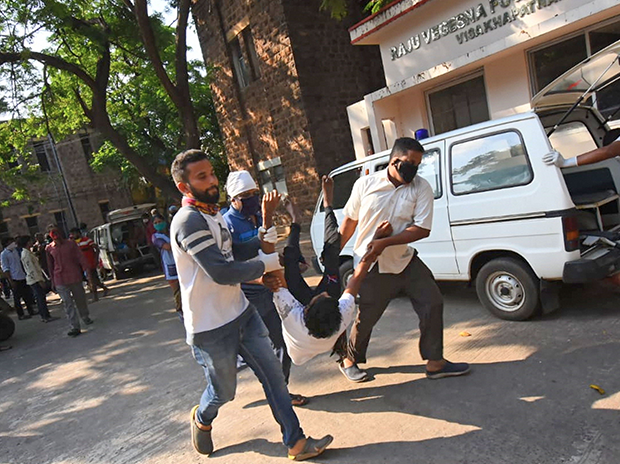Vizag Gas Leak: LG Polymers' India Journey Is Riddled With Controversy

LG Polymers India, the company that owns and operates the chemical plant in Visakhapatnam (Andhra Pradesh) from where poisonous gas leaked on Thursday killing several locals, is no stranger to controversies.
Set up in December 1996, weeks before Korean major LG Electronics entered India, the plant has been at the centre of legal battles since its association with the $23 billion LG Chem.
Originally set up as Hindustan Polymers in 1961, the manufacturing unit landed up in liquor major UB Group’s McDowell’s lap in 1978. As South Korea’s LG Group geared up to establish its footprint in India’s consumer durables space in the mid-1990, it acquired the plant under a share transfer deal against its Rs 100 crore investment in the plant.
Acquiring the polymer business was crucial for LG. The brand that became the leading consumer appliances player in the country had to keep costs in check and protect its technology. A lack of adequately skilled workforce at the time forced new entrants like LG to keep all key component manufacturing in-house.
ALSO READ: Vizag gas leak highlights: 11 dead, criminal case against plant management
“While LG decided to import large components like compressors from Korea, importing cheaper components like body parts was not economically feasible. However, no major manufacturer in India at that time was technologically, or otherwise, capable of producing such components. Thus, many such plants were acquired by the technologically superior new entrants like LG and Samsung,” said a senior industry executive, who began his career at one such LG plant in the mid-1990s.
Controversy broke out soon after it formed the subsidiary LG Polymers India to operate the unit in Visakhapatnam. A land transfer and use agreement between its previous owner and the Andhra Pradesh government dragged both LG and the state to court. Unauthorised use of land, like setting up a luxury resort on land offered for industrial purposes, and breaching the state’s land ceiling norms continue to remain bones of contention between the parties.
According to ESA Sarma, a former secretary to the central government, the firm received approval for its controversial expansion plan last year. “Such clearances should have come from the Union environment ministry, but the local pollution control board allowed it to expand despite it being in the hazardous industry category,” he told Business Standard.
ALSO READ: Explained in pictures: All you need to know about Vizag gas disaster
LG Polymers’ legal fight involving its own parents, however, is quite unique. A deal for using the LG trademark, with its Korean parent LG Chem, led to a litigation involving all key companies — from LG International Corporation and LG Corporation (both from Korea) to its direct parent here, LG Chemical India.
A murky internal trademark deal, violating rules for distribution of royalty collected from LG Polymers between its Korean parents and global associates haunted the firm in early 2010s.
A detailed questionnaire sent to LG Chem remained unanswered.

In 2019, LG Polymers raked in Rs 142 crore in revenue, while its net income stood at about Rs 4 crore. Filings with the Registrar of Companies show that it has Rs 126.33 crore paid-up share capital and a bunch of group veterans run the show. Sunkey Jeong, its managing director, also heads the board of LG Chemicals. While LG’s Hyun Seok Jang sits on the board of all key LG Chem firms in India, including Polymers’.
ALSO READ: Coronavirus LIVE: 77 inmates, 26 officials of Mumbai jail test positive
LG Polymers is a string in the chain of companies through which LG Chem operates here. At least two other subsidiaries — LGC Petrochemical India in Mumbai and LG Chem Life Sciences in Gurugram — are operational and offer products and services like consultancy and advocacy in the fields of petrochemicals and pharma.
With three subsidiaries, LG Chem’s India presence is sizable, lesser only than in South Korea, China, the USA and Vietnam.
BoE Loosens Capital Rules
The Bank of England has taken a significant step towards easing post-crisis regulation by lowering its estimate of the c... Read more
Monzo Looks For US Banking License
Monzo is preparing a renewed push to secure a US banking licence, four years after abandoning its first attempt when tal... Read more
Crypto Firms Push Into US Banking
America’s cryptocurrency companies are scrambling to secure a foothold in the country’s traditional banking system, ... Read more
Parallel Banking: Stablecoins Are Now Global
Parallel Banking: How Stablecoins Are Building a New Global Payments SystemStablecoins—digital currencies pegged to tr... Read more
JPMorgan Deploys AI Chatbot To Revolutionize Research And Productivity
JPMorgan has deployed an AI-based research analyst chatbot to enhance productivity among its workforce, with approximate... Read more
Private Equity And Banks: The Complex Web Of Leverage
Private equity has emerged as a significant force in the global financial landscape, driving substantial growth and inve... Read more

